Police Chief Foti Koskinas (left) and Officer Charles Sampson. Photo courtesy of Westport Police.
Post by Barry Kresch
Tesla Police Vehicle Brings Large Monetary Savings
- The purchase premium is recouped in one year.
- After four years, the savings are enough to pay for another Tesla.
- One EV saves 23.5 tons of CO2 emissions annually.
This blog post will discuss the financial aspects of the analysis. A subsequent post will describe the avoided emissions and health costs.
A Big Splash
Using a Tesla Model 3 for police duty was a new idea back in Dec. 2019 when the Westport Police acquired one for use as a fully customized police cruiser, going into service in Feb. 2020. This was the second Model 3 to be acquired by a police force (Bargersville, IN was the first), but according to the Westport Police, this was the first one to be fully tricked out for law enforcement. The Model S or X would also be cool patrol cars, but the lower price-point of the Model 3 made it a more financially realistic option.
The purchase caused quite a splash, generating hundreds of inquiries from all over the world. Since then, there have been some other communities that have gone the same route. To the best of our knowledge, nobody has published a dive into the financials, including the customization.
The police gave us some very positive feedback early on about using the vehicle. This included how its performance enables it to catch up to a speeding vehicle in less time than a gas-powered patrol car, reducing the danger to other motorists, pedestrians, and the police themselves.
When a police vehicle is out in the community, especially at a public gathering, photo ops are common. The usual photo op is with the kids, who like to be photographed behind the wheel of a patrol car. With this car, it is the adults asking for photos.
At the time the purchase announcement was made, much of the attention was focused on the headline purchase price. Sure, the Tesla Model 3 is green. In fact, it is green even by EV standards with a 121 MPGe EPA rating. But is it a prudent use of taxpayer funds to purchase a vehicle costing $52,290 compared to $37,000 for a Ford Explorer, the recent mainstay of the Westport patrol car fleet?
This blog reported extensively on the vehicle when it entered service. The story was picked up in other places, too, including local blogger, Dan Woog, who published a story in December 2019 that generated over 50 comments. Most were supportive, but there were doubting Thomases who wrote, “$52,000 – what a joke.” Or “A Tesla is essentially a luxury item and a novelty; what a wasteful and obnoxious mismanagement of our tax dollars.”
While EVs are typically more expensive to acquire than a comparable conventional, or ICE (internal combustion engine) car, the total cost of ownership, which factors in fuel and maintenance, is often lower. This car turned out to be an extreme version of the savings on a total cost of ownership basis.
The Westport Police worked with Sustainable Westport before the purchase to estimate the numbers and there was a high confidence level that the lower operating costs of the Tesla would translate to payback within three years, plus the tantalizing possibility that the native tech in the Tesla would offer savings on the extensive customization that occurs for a law enforcement vehicle. Fortunately, Westport leadership is committed to lowering emissions and they, including First Selectman Jim Marpe and Police Chief Foti Koskinas, had a bias to action.
Fast Recoupment
The new headline is that the payback happens in year one. By year four, there are enough savings to buy a new Tesla. The details get a little more complicated and I will lay them all out. All data regarding the purchase, customization, and operating expenses come from the Westport Police. At my request, the analysis was reviewed by the Finance Department of the Town of Westport, which has confirmed the accuracy of the data and supports the conclusions.
I use actual data, where available, and due to the relatively short time frame, projections based on the data for future years, done in consultation with the police.
This Tesla and The Next
This car was never not going to save money. The cost of law enforcement customization is substantial, more than the cost of the Ford Explorer. The Tesla, due to its first-mover status, was given significant discounts from the two companies that Westport uses for this work (Whelen Engineering and Fleet Auto Body, which are both CT companies). Going forward, that free lunch is off the menu. Consequently, when discussing the data, I refer to this vehicle as the Tesla “Pilot,” and a second, hypothetical vehicle, as the Tesla “Next,” where I don’t count the one-time discounts to have a better comparison with the Ford ICE.
Also, this comparison assumes outfitting a car from the ground up. In real-life operations, if a vehicle is replaced with a like vehicle, much of the customization can be reused. The Westport patrol fleet is made up of Ford Explorers and Crown Victorias. The latter model has been discontinued so reuse is not possible when replacing those.
The Car
This Model 3 was the long-range, all-wheel drive, performance version. The police did not purchase full-self driving (which their insurer would not underwrite, though it was moot because they weren’t going to buy it anyway).
Customization
The biggest single item in the customization is the license plate reader, and it is here that there was a savings of $10,000 ($8,000 vs $18,000) due to taking advantage of the technology native to the Tesla. As far as Pilot discounts, there was no charge for added cameras, lights, siren, and the weapons rack. These discounts amounted to just over $14,000.
The Pilot was not outfitted with a prisoner transport cage/partition since that was not needed for its duties. For purposes of comparison with the Explorer, the partition was included in the Next vehicle.
There are two items that applied only to the Tesla. One is a spare tire for $800. (The Ford comes with a spare.) The other is a charging station at a cost of $1000 for hardware and installation. These are categorized as “customization” since they come after the vehicle is purchased. The department is getting two shifts per day on a single charge and charging the vehicle overnight. This is assumed to be the usage pattern of future Teslas, so the conservative assumption on charging is that the charging equipment expense will be required for each Tesla procured and it is included in the Next vehicle. There could potentially be a savings opportunity in the future with a dual-port charger.
The other item, charged to all cars, was a police computer.
Exploiting the native Tesla tech is still a work in progress. There is the possibility of future savings but for this comparison, no further savings are assumed. The customization totals for each vehicle are displayed below. The Pilot vehicle, due to the discounts, cost savings from the license plate reader, and lack of a prisoner partition has a $24,600 lower cost of customization. In other words, based on the customization alone, the purchase premium has been more than recouped. The Next vehicle, without all the discounts, still has a lower customization cost than the Ford in the amount of $8200 due to the license plate reader savings, partially offset by the charging station and spare tire expenses.
One thing that Tesla did was enable the wiring of all the electronic accessories (lights, siren, etc.) into the large battery. That made it unnecessary to add a second 12-volt battery (which is how other police departments have handled this item). In the case of the Ford patrol car, a heavy-duty alternator is how the extra load is handled. (The HD alternator is included in the base purchase price of the Ford.)
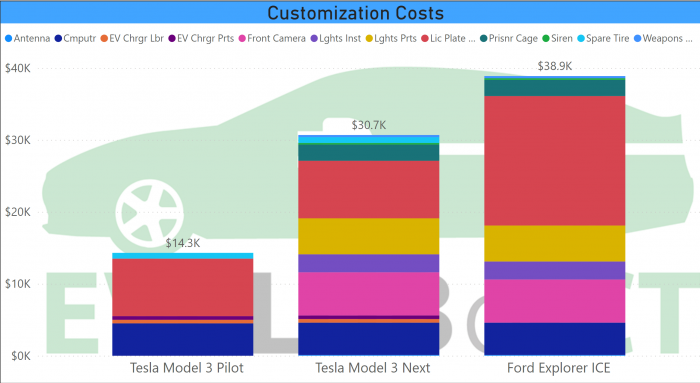
Ongoing Costs
Aside from fuel, these are the ongoing regular maintenance items that are included in the data.
Both vehicles: brakes and tires.
With electric vehicles, regenerative braking, where the engine slows the car and stores some of that kinetic energy in the battery (instead of its being dissipated as heat), greatly reduces the wear on the brakes. The scheduled brake servicing for the Tesla is once every two years. It is possible the brakes will last longer, but the police use involves hard stops, which will engage the friction brakes, and this is thought to be a conservative estimate. Brake servicing history on the Explorer is twice per year.
The police have remarked that they are pleasantly surprised that the tires are holding up better on the Tesla, which they attribute to a superior suspension. I was surprised, too. Normally, tires are the one area where an EV does not save money. Most EVs use low rolling resistance tires. These maximize range but are not known for long life. In the case of the Westport PD, they are using the same tire for both the Ford and the Tesla. It is possible there was a slight range-loss because of this. They plan to replace the Tesla tires once every two years, compared to every year for the Ford.
Ford only: oil/filter changes, transmission servicing, catalytic converter, water pump, spark plugs, alternator.
The costs were calculated based on driving 23,060 miles in a year.
The EV charger that was installed by the police is not sub-metered. Tracking electricity consumption was a manual affair of tracking mileage and battery state of charge before and after each day. Going forward, the police have subscribed to Tesla-Fi, so there will be an opportunity to tighten those numbers, plus track battery degradation. Based on the data we have, the cost of electricity was 60% less than it was for gas. Also, keep in mind that this car is a 2020 model year, meaning it was before Tesla began installing heat pumps in its vehicles. This will reduce energy consumption in cold weather. Finally, there is a new EV Rate Design currently being adjudicated by the Public Utilities Regulatory Authority. This has the potential to reduce the cost per kilowatt hour of electricity, depending upon the final rulemaking, how it applies to municipalities, and whether the police could live with a managed charging arrangement. The police would have to install smart chargers, which are more expensive than the dumb charger they have now, but that cost differential would likely be subsidized in this scenario.
The chart below maps the savings from fuel and maintenance on a year by year cumulative basis for 4 years. Bands of color represent items in a consistent way across all 4 panels and all 3 bars and are identified in the legend. In year one, there is already a savings of $8.3 thousand, due to the lower fuel costs for the Tesla, along with the cost of quarterly oil/filter changes, brake servicing, and tire replacement for the Ford. From there, the savings accrue even more quickly due to ICE parts (e.g. the catalytic converter) needing to be replaced, so that by the time we get to 4 years, the savings total $31.5 thousand. This is considerably more than the purchase premium and almost as much as the purchase cost of the Ford.
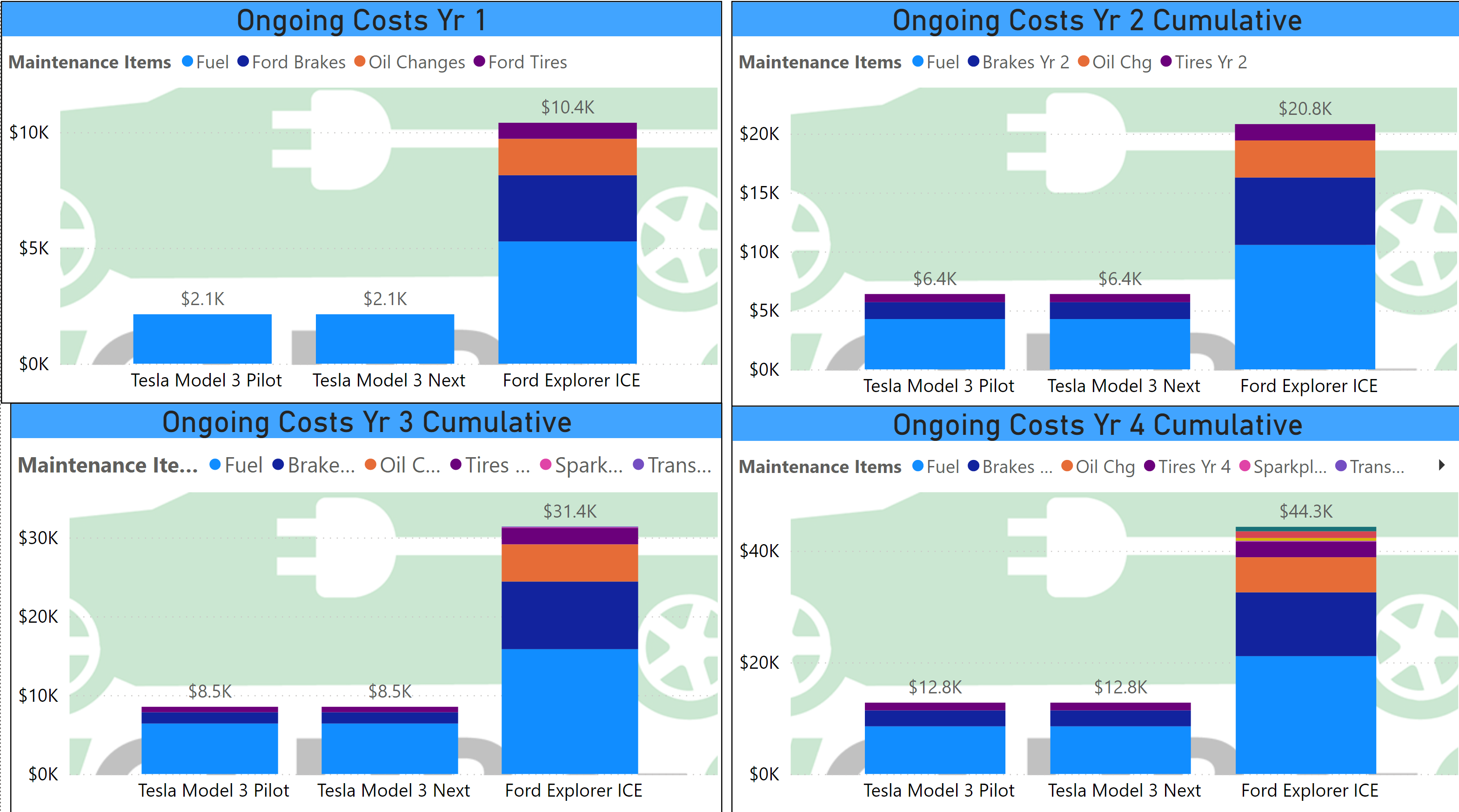
Service Life
The documented service life of the Ford Explorers is four years. Based on what the police have seen to date, they are planning for a six-year service life for the Model 3. This is big. Costs are calculated on both a cash and amortized basis.
Total Costs – Cash Basis
The chart below shows the total cost of each vehicle with subtotals by category (purchase, customization, ongoing) for each of 4 years. This looks at the costs on a cash basis. The costs are cumulative. Since we are looking at the costs on a cash basis, the 2 blue bands, representing the purchase and customization costs, recognize these expenses in the first year and they don’t change. The ongoing cost does increase each year as more fuel is used and additional maintenance items are performed. The maintenance load on the Ford, in particular, gets heavier as the years go by and things like the catalytic converter and water pump need to be replaced. Therefore, the year 4 cost is the total spent on fuel and maintenance to this point. Four years is the chosen interval as it corresponds to the service life of the Ford Explorer.
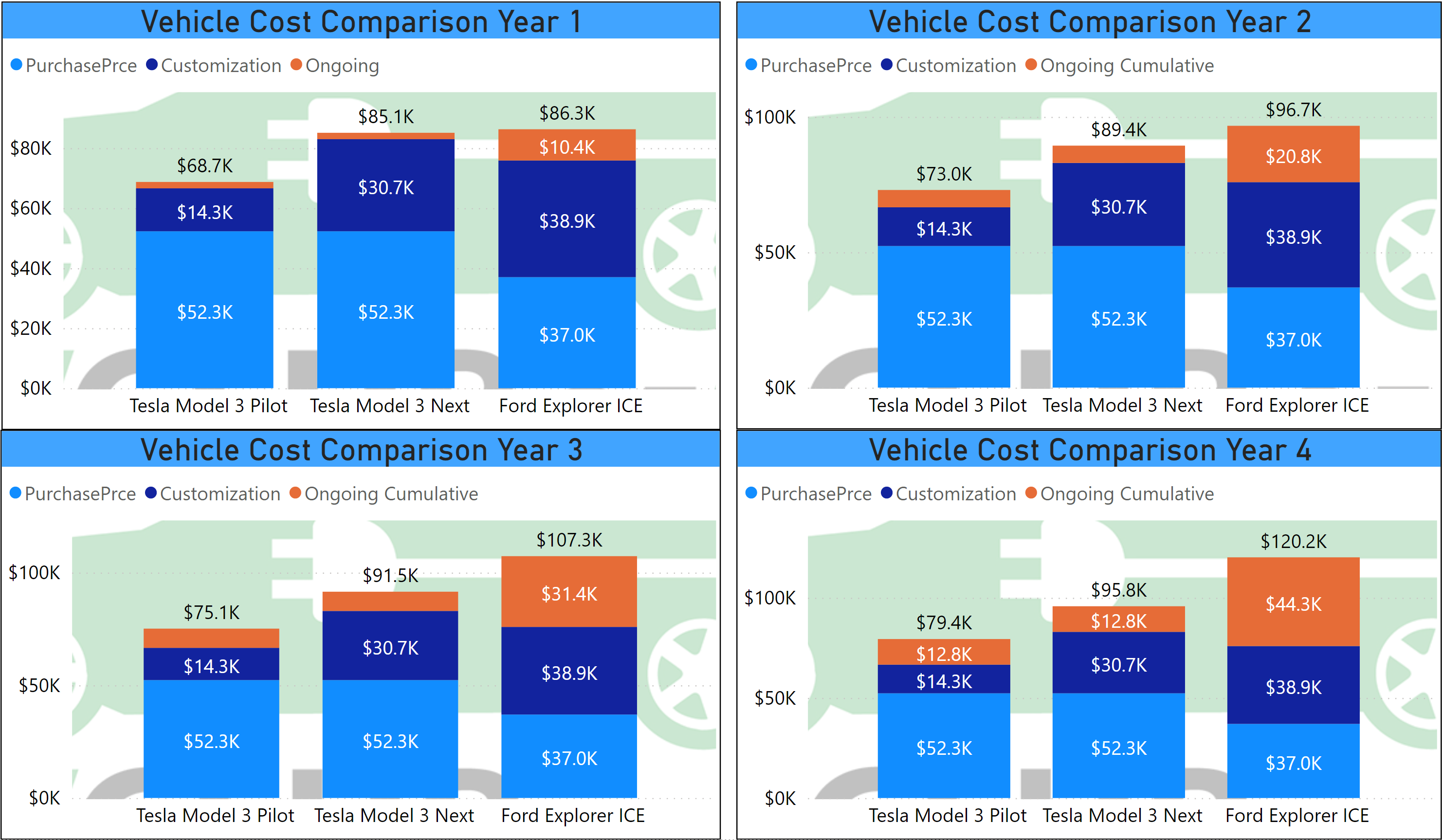
This next chart summarizes the categories into a grand total and displays the 4-year cost trend for each vehicle. This is still on a cash basis and it ties to the totals in the category chart above.
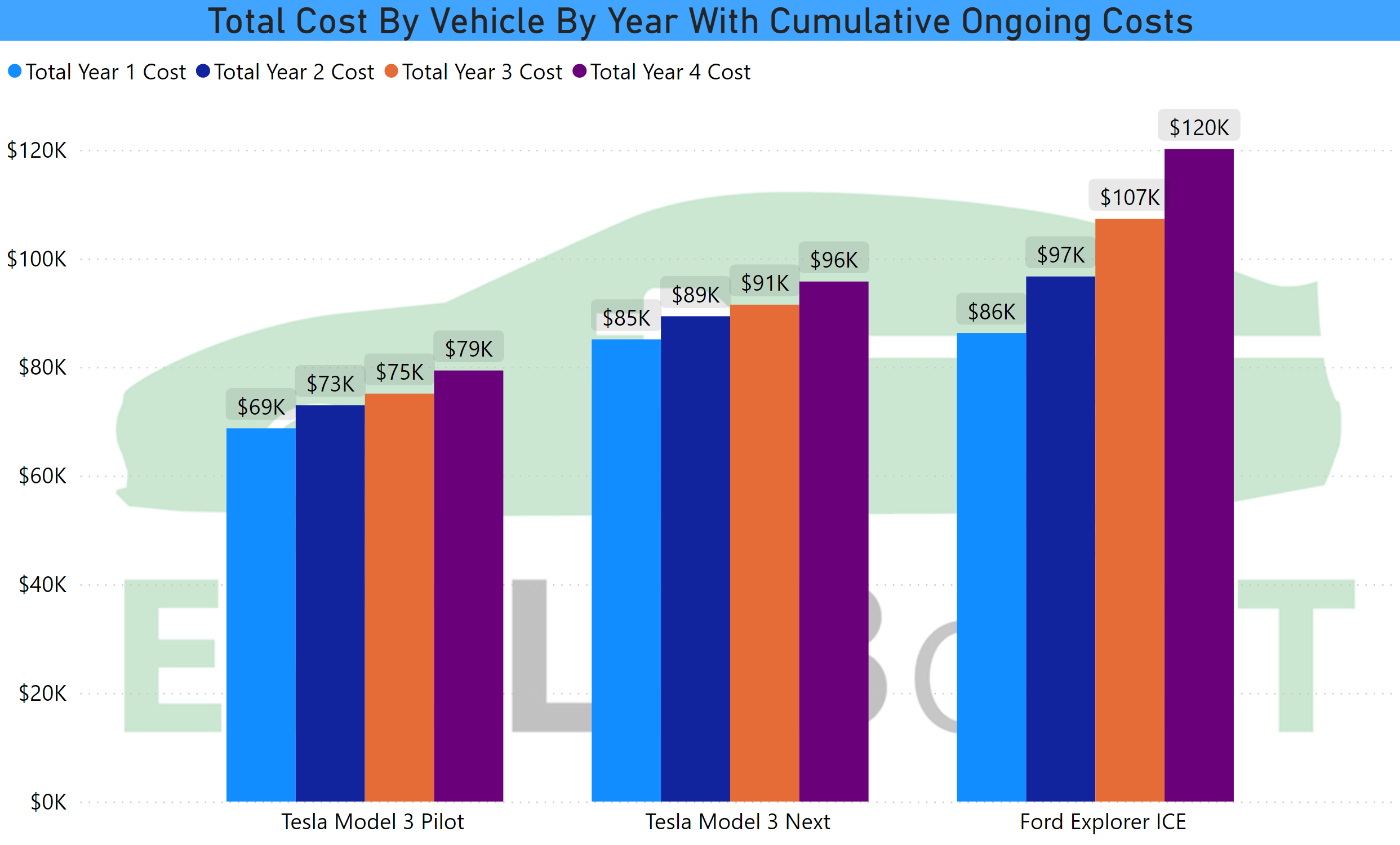
Total Costs – Amortized Basis
None of the charts to this point have taken service life into account. It should be noted that even on a cash basis, the costs for the Teslas are considerably lower. The chart below reprises the category format, except that the purchase and customization costs are divided by the number of years in the service life of each vehicle. This is why the fixed costs increment upwards each year.
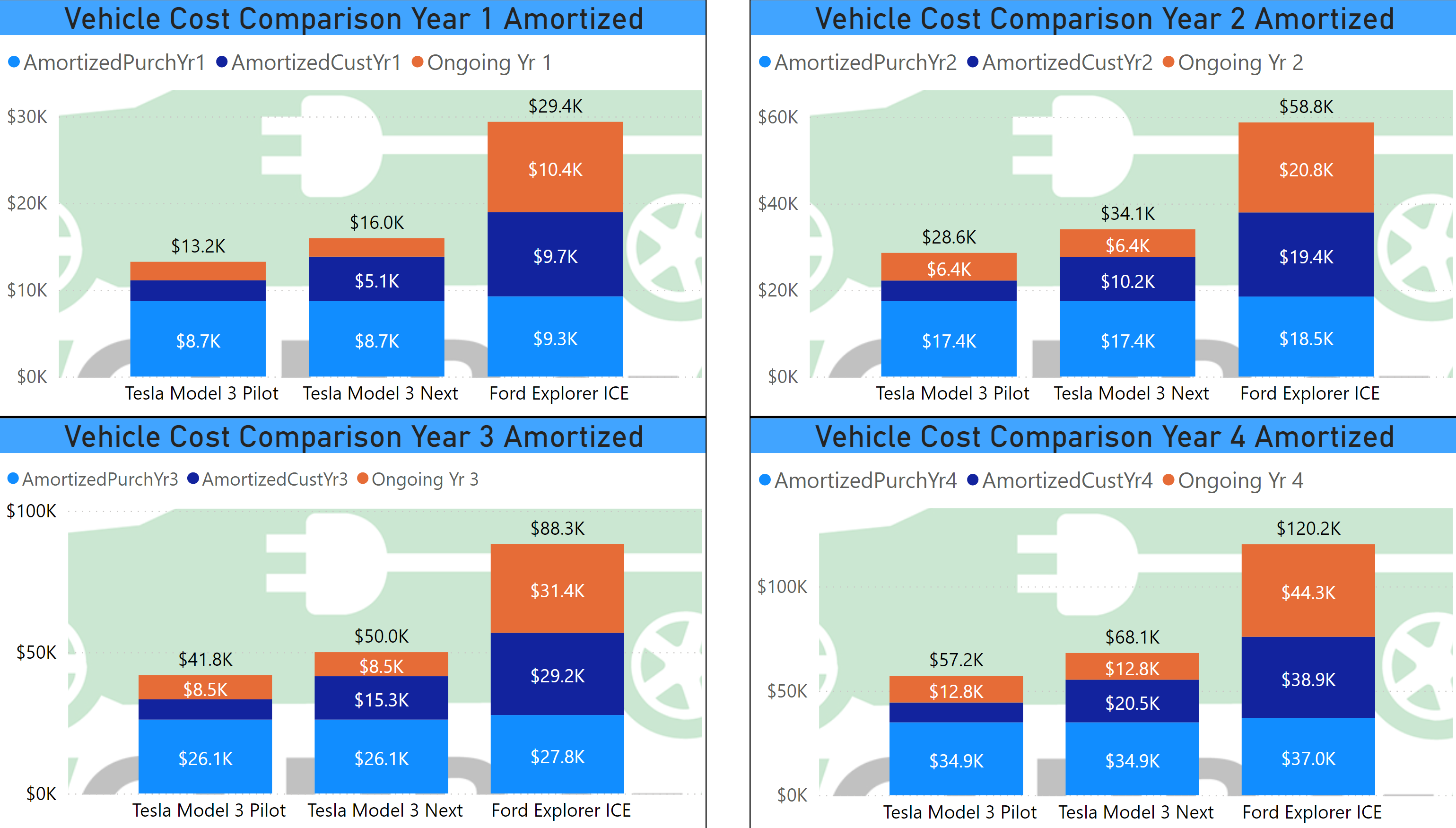
This is what the total costs for each vehicle for each year look like. The magnitude of the difference between the Teslas and the Ford Explorer is greater because, after 4 years, only two-thirds of the Tesla purchase and customization costs are amortized. You will notice that year 4 of the costs for the Ford is the same is it appears 2 charts above, because at that point, the vehicle has been fully amortized.
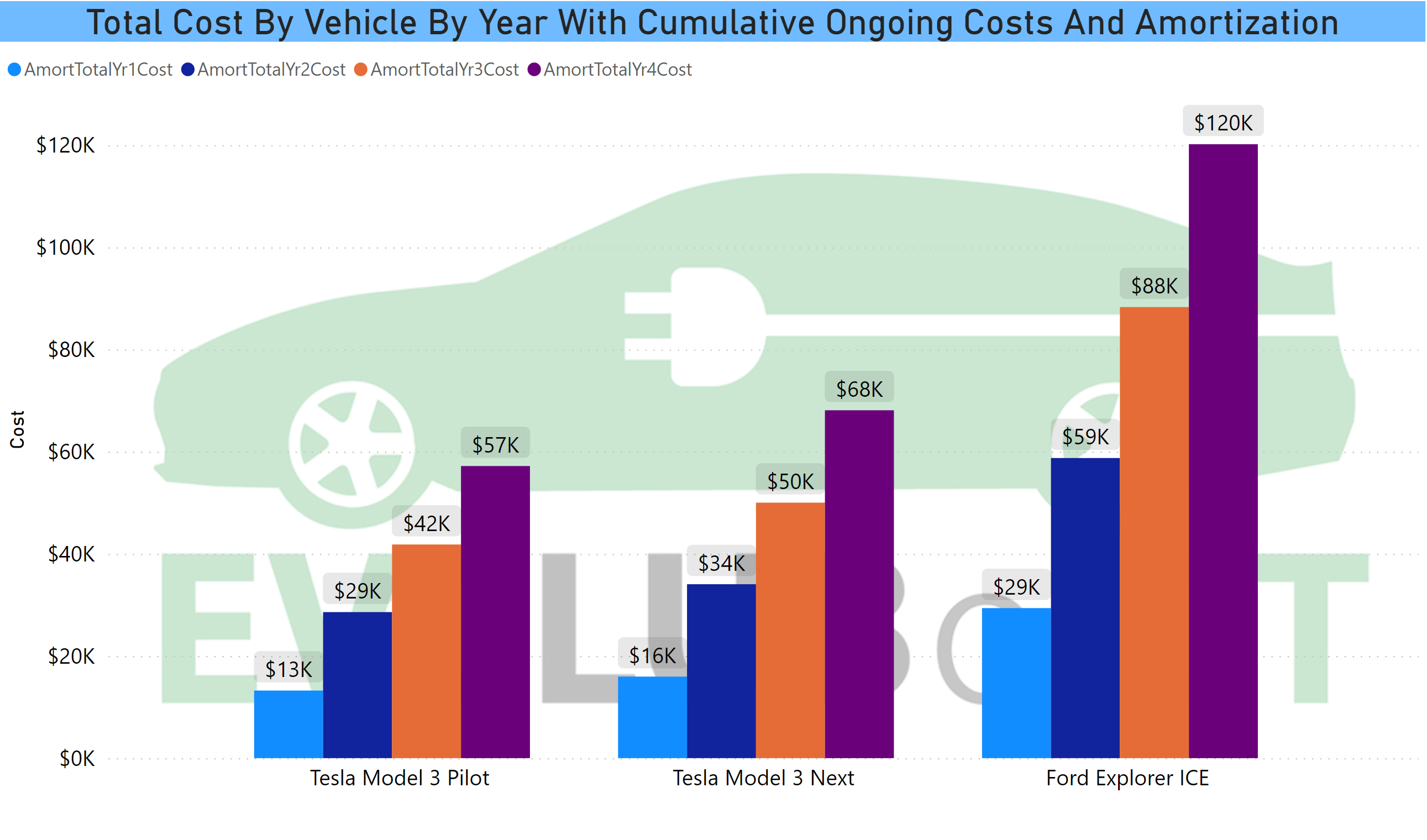
You can easily see the differences are substantial and we have done the math on the savings for you in the two charts below. The first shows the savings for the Tesla Pilot and the second shows the savings for the Tesla Next. Each chart displays side by side the savings on a cash and amortized basis.
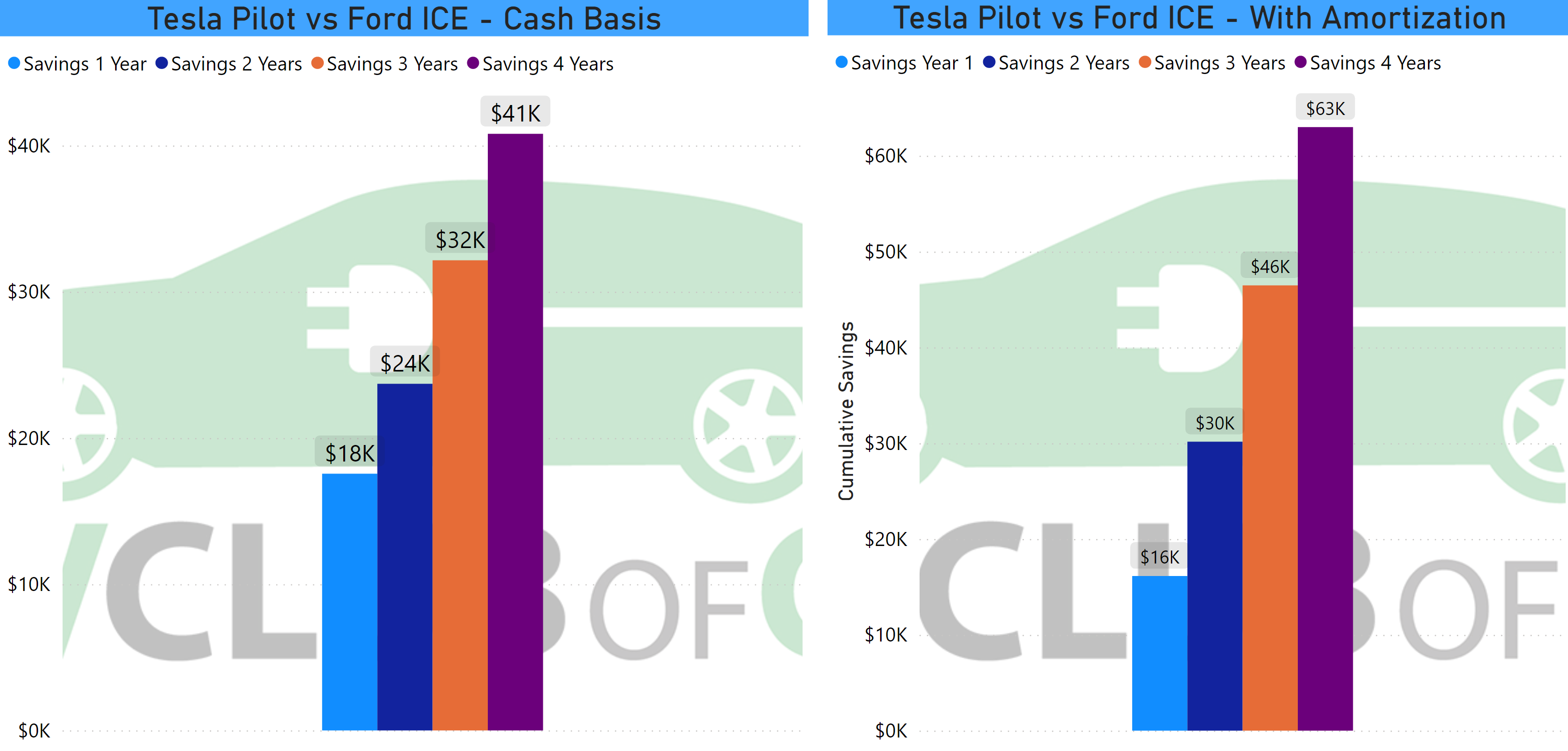
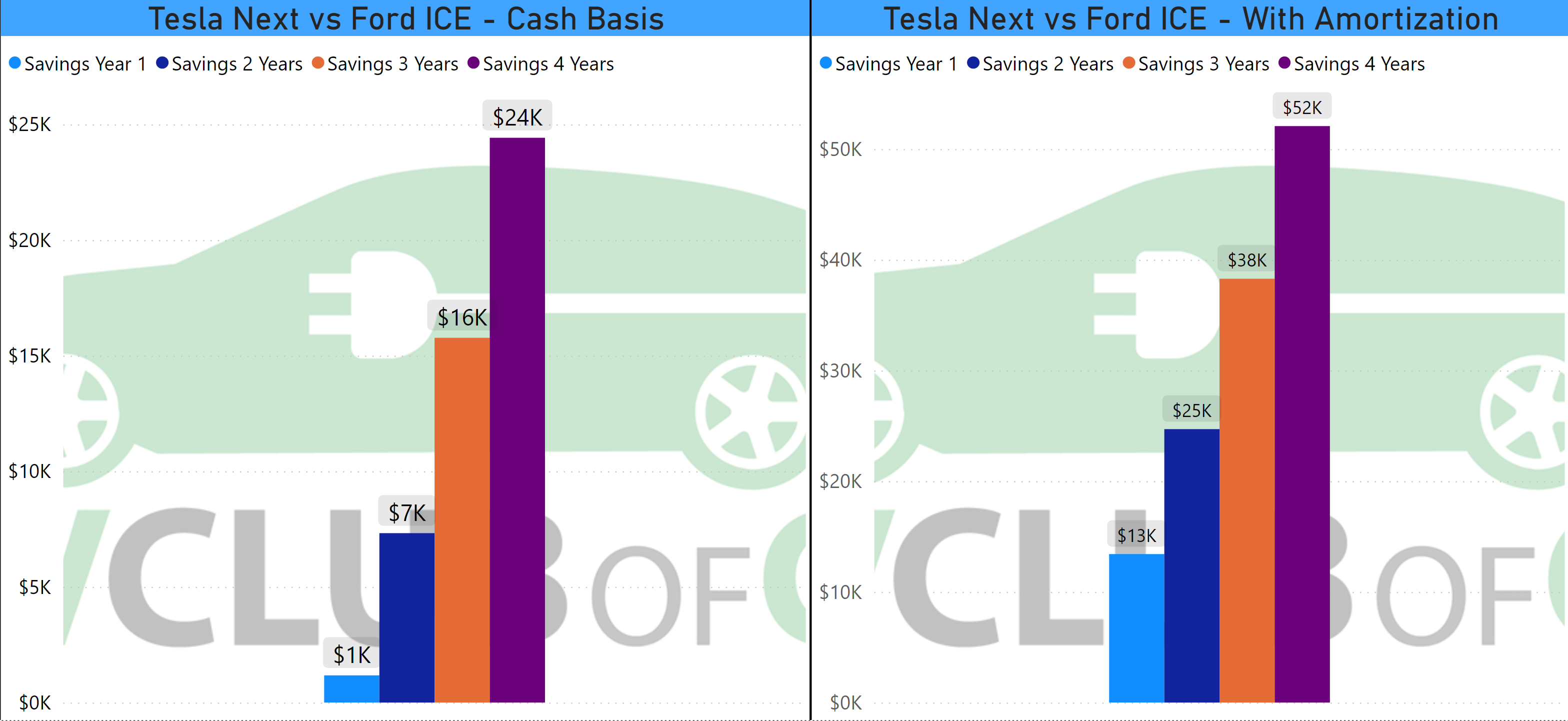
As can be seen, the extraordinary discounts for the Pilot vehicle generate an enormous savings of $63,000 after four years on an amortized basis. But even the Next vehicle more garners significant savings even on a cash basis. On an amortized basis, the $52,000 savings are almost the exact cost of the original purchase price of the Model 3.
The bottom line: This is good for the bottom line!
Closing Note: The police buying a Tesla, was a toe in the water, a pilot. As demonstrated in the data, the payback happens in the first year and the savings are substantial after 4 years. The ramification is very clear: It is possible to move aggressively to replace every ICE vehicle that turns over with an appropriate EV without jeopardizing constrained financial resources. It’s not just about Tesla. The Town of Westport recently acquired 2 Chevy Bolts. The police have several other plug-in vehicles such as the Toyota Prius Primes that are used for parking enforcement. It is about reducing emissions while cost-effectively matching the vehicle to the use case. The potential is there to save millions of tons of emissions and millions of dollars over the course of 10 or 15 years.
Even better news is that future savings could be greater. In the case of the Tesla, making greater use of the native technology is still a work in progress. There could be more savings, but since we don’t have anything definitive, I didn’t want to be overly speculative.
Something new that is happening is the new EV Rate Design issued by the Public Utilities Regulatory Authority.
Even though the final adjudication was issued on July 14th, there are still working groups filling in the details. We should know everything at some point in Q4. The program takes effect in January 2022. But we do know that it includes subsidies for charging station purchases, make ready, and discounted electric rates.
So I will close by borrowing a Tesla term and say there is no reason not to move forward in Ludicrous Mode.
This is a recent video that was made with the Westport Chief of Police, Foti Koskinas, at an outdoor press conference where he was speaking about the first year of the vehicle being in service.
Inquiries can be sent to EVClubCT@gmail.com

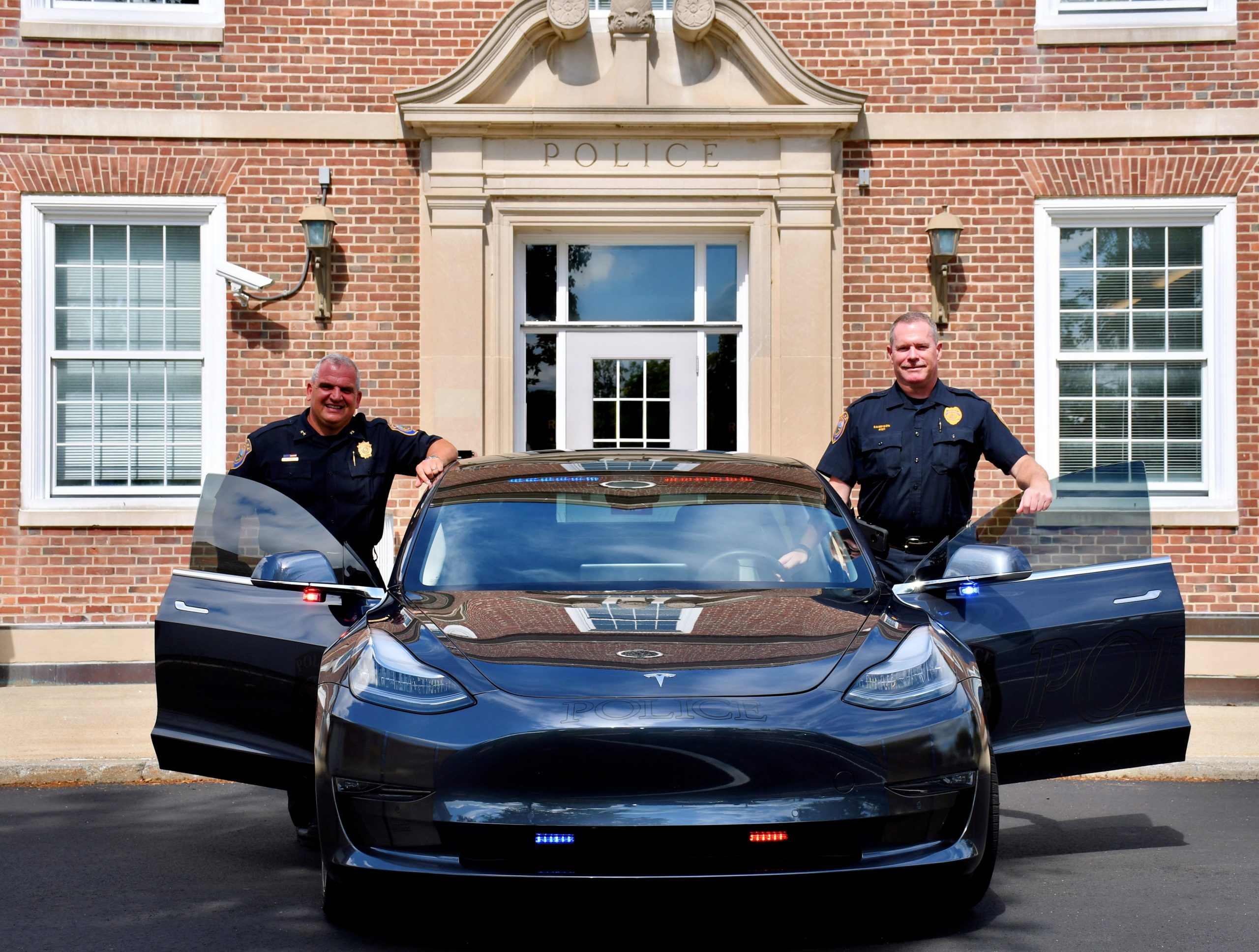
One thing I do not see here is service hours. The Ford could be gassed and jumped into by second and third shifts making it an available cruiser 24 hours a day. I would assume the Tesla would be “not available” every other 8 hour shift due to charging. So if the charge time was eight hours than the Tesla would be available for 1st and 3rd shifts on say Monday, which would then require a second Tesla to be charged for shift 2. Tesla 2 would be charging during shift 3 and would go out on 1st shift Tuesday etc.. So you would need to figure in the cost of a second Tesla to maintain 24 hour service availability which one Ford could do. Don’t get me wrong, I think electric cars have a great future ahead but you cannot compare cost savings by the car alone, availability needs to be figured in.
They use it for 2 shifts per day, then charge overnight. If they need it for a third shift, they have access to a DC fast charger. Also, electric cars require less maintenance, break down less often, and spend less time out of service.
It is undeniable that the cost of the Model 3 is well worth it and it is a great patrol unit on paper. Our group now has a few Explorer SSV Hybrid models and are seeing a decent cost savings. I am curious about any feedback you may have received from any officers that are in the unit for an 8-10 hr shift. It seems that compared to the Explorer, it could be a bit tight with a vest and duty belt along with the standard features (computer, radio, light controls, etc.).
The feedback we have received from the police is that they love it! The only thing we heard is that they may have to replace the seat at some point due to wear and tear from the officer’s sidearm, which was not included in the model since we have no data for it.
could a dual motor 3/Y suffice? I’m sure in the mid 4’s it still kills the acceleration of the ICE vehicles and the savings over the performance could add even more edge on TCO?
Frank Staltaro, this could be possible. The police have told me they are evaluating it.
For a measly $2K software upgrade, the dual motor Model 3 will get you a 0-60 mph time to about 3.9 seconds. You can authorize this from your cell phone and start driving faster very soon thereafter. Of course there are YouTube videos of people testing this.
https://www.roadandtrack.com/new-cars/a30294938/tesla-model-3-acceleration-boost-upgrade/
If their objective was to save money they should have looked at the Prius5.
Thank you for this comment. The Prius does not meet the performance requirements for a patrol car. The department has 2 Prius Prime PHEVs that are used for parking enforcement.
Alan, I wrote about the technical aspects of this Model 3 police cruiser back in Feb of 2020
https://TinkerTry.com/tesla-model-3-westport-ct-police-cruiser-tech#video
where I featured Zac and Jesse’s great video!
I also recorded a short video clip here, revisiting this history-making Model 3:
https://www.youtube.com/watch?v=fxFeEpjZwRM
where you’ll also see the use of the frunk highlighted.
I would love to get another chance to record something about these savings, maybe Barry (the author) and I can come up with some ideas.
I watched a fascinating video from when the Westport Police Department first accepted the Tesla on the YouTube Channel, “Now You Know”. Zac and Jesse, the hosts, visited the station and saw the differences between their normal ICE vehicles and the Tesla. The Tesla had much more usable interior room for weapons and was able to keep the emergency medical kit in the frunk, where it is easily obtainable, and kept away from the weapons in the trunk. I would like to see them do a follow up program on just how much was actually saved, proving the lower cost of ownership. This would show, not only other Police departments, but the man in the street that EV’s are a great investment for drivers but the planet as well.
We, Long Island tesla club met with the officer and asked many questions. Fun day for all..!!